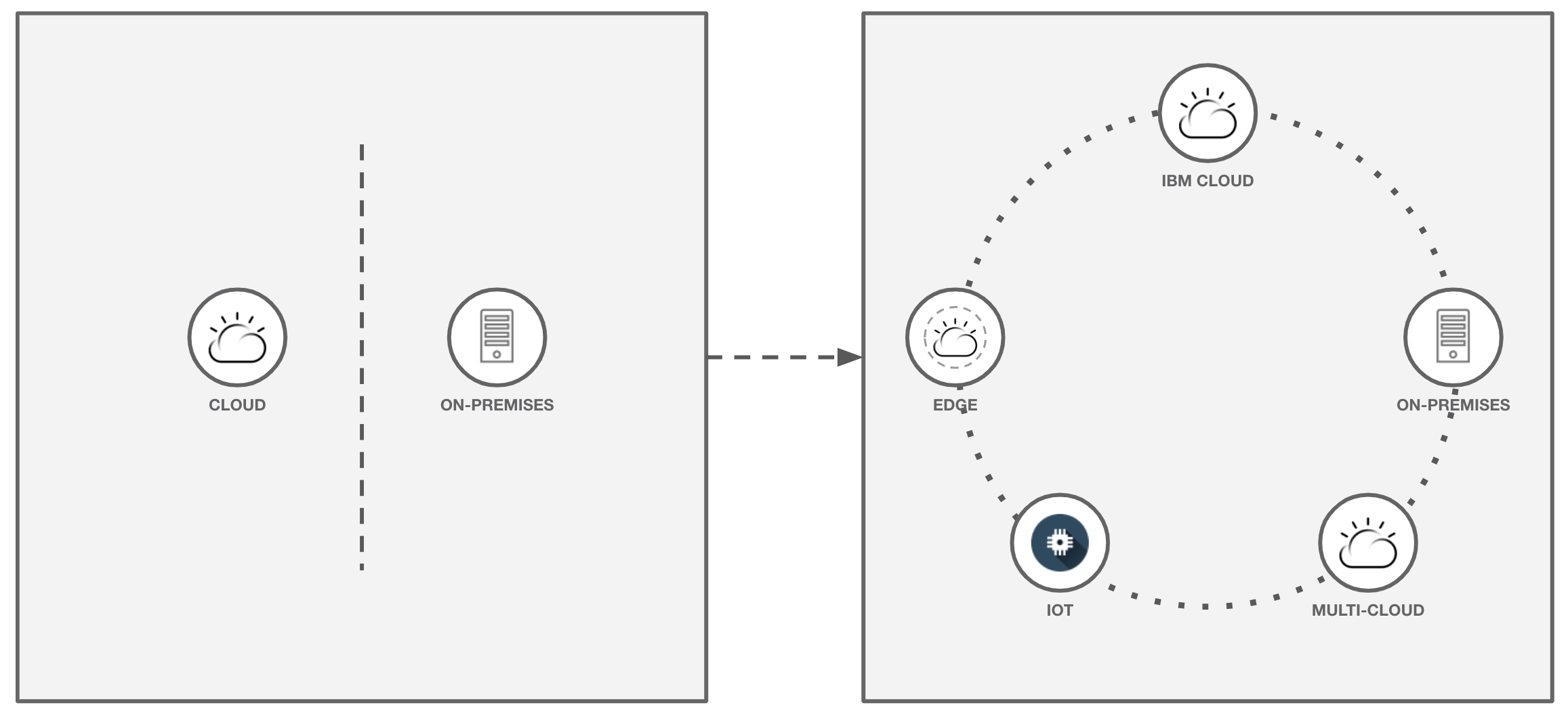An overview of the new IBM Cloud Satellite distributed cloud
Originally published on: https://developer.ibm.com/articles/overview-of-the-new-ibm-cloud-satellite-distributed-cloud
This article discusses motivations for moving to a distributed cloud and a new way to get started with it: IBM Cloud Satellite.
The phrase distributed cloud refers to public cloud services dispersed across various geographic locations that are chosen to meet application requirements, but the operations and governance of those services are still centrally controlled by a single public cloud provider.
With the beta launch of the IBM Cloud Satellite, you can use IBM Cloud anywhere, on the IBM public cloud platform, on premises, or at the edge, delivered as-a-service from a single point of control. With IBM Cloud Satellite, you can focus on app development, not platform differences.
Beyond the buzzwordsPermalink
Public clouds matured considerably over the last decade. They are now seen as reliable, secure, and cost-effective for a variety of scenarios. They are usually the first option for developers to deploy a new application and favored by startup organizations that do not have the capital to purchase racks of servers. Enterprises use public clouds too. According to IDG, 81% of enterprises use the cloud in some way and 55% of organizations currently use multiple public clouds. However, several research surveys over the years noted that many enterprise applications did not move to a public cloud and remain on premises. Why is this?
Notably, non-tech industries such as health, retail, and banking lag behind when it comes to cloud adoption. Several reasons prevent organizations in those industries from moving their workloads to a public cloud. Quite often the barriers are data locality requirements (particularly for healthcare and banking) and low latency requirements (particularly for media and telecommunications). As a result, most enterprises are running hybrid environments of on-premises and cloud. Now, that architecture is changing to a more distributed environment with multiple public clouds, data centers, and edge components.

However, this move brings in some problems of its own:
- Inconsistencies between public cloud and on-premises environments for both developers and operations.
- Fragmented visibility into applications that run across hybrid architectures.
- Lack of access to best in class public cloud services everywhere you want.
- Increasing complexity when you try to manage across public cloud, edge, and on-premises locations.
- Trouble with balancing your desire to develop more quickly with the realities of regulation, security, and compliance.
IBM Cloud Satellite can help solve all of these problems, while allowing you to keep a cloud-agnostic mind set and stay on-premises when necessary.
Overview of the new IBM Cloud Satellite distributed cloudPermalink
The official value statement for this new offering is: IBM Cloud Satellite provides IBM Cloud services anywhere a client needs them, delivered as-a-service from a single pane of glass controlled through the public cloud.
IBM Cloud Satellite is designed for enterprises that:
- Have complex, distributed environments that span public cloud, on-premises, and the edge.
- Want a simple on-demand experience for deploying core application services such as AI, databases, containers, and object storage.
- Prefer to focus resources and skills on the business instead of securing and managing such an environment on your own.
- Require a single pane of glass to organize and govern services across environments.
How IBM Cloud Satellite worksPermalink
IBM Cloud Satellite extends the IBM Cloud control plane to locations. Locations are places outside of the IBM public cloud where you can run services and applications. Each location is populated with hosts to run cloud services and applications. Hosts are Red Hat Enterprise Linux machines from your data center or the edge. A location connects to IBM Cloud by using a link.
In the following video, developer advocate Sai Vennam provides a quick visual overview of how IBM Cloud Satellite can help you manage critical apps from any location.
Registering a hostPermalink
After a location is created in the IBM public cloud, a script is generated to run on the host. Running this script registers your host to the new location. There are no racks or appliances to purchase, and any hardware can be used. After a host is registered, you can begin deploying IBM Cloud managed services to the host.
Services available to an IBM Cloud Satellite-enabled hostPermalink
As IBM Cloud is built on Kubernetes, it can more easily bring new IBM Cloud services to locations. IBM Cloud Satellite-enabled hosts will be able to provision:
- Container orchestration platforms
- Managed databases
- Event streaming services
- DevOps tools
Benefits of IBM Cloud SatellitePermalink
Having IBM Cloud serve as the control plane for your distributed cloud allows for consistent deployment across environments and simplified management of cloud resources such as identity and access management, key management (including Keep Your Own Key), and billing and metering. In addition, your enterprise benefits from centralized observability for applications and services, such as logging data sent to IBM Cloud Log Analysis with LogDNA and monitoring data sent to IBM Cloud Monitoring with Sysdig.
IBM Cloud Satellite and open sourcePermalink
As a developer, I believe that using open source software is essential to building enterprise software. IBM has a strong history and commitment to open source and building IBM Cloud Satellite was no different. On the setup side, IBM Cloud Satellite uses Razee for configuration management and Istio for mesh networking. When your location is set up, IBM Cloud Satellite offers Red Hat OpenShift as a Kubernetes platform, and popular open source databases as options.
SummaryPermalink
If you work for an organization that is concerned about data locality requirements or low latency requirements, then pursuing a distributed cloud architecture might be beneficial for you. Consider signing up for the IBM Cloud Satellite beta to test the technology.

